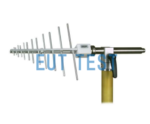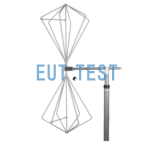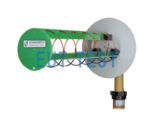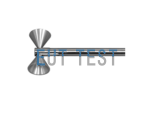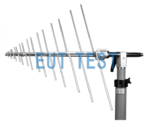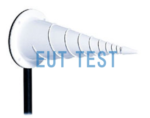Introduction:
UBA 9116 is a UHF broadband antenna authorized by Schwarzbeck Germany and distributed by EUTTEST Shenzhen, available frequency range covers 300 MHz - 1 GHz with a maximum input power of 10 W. The biconical UHF broadband antenna UBA9116 offers in the UHF range (300 MHz - 1 GHz) these attractive features. With a higher antenna factor (negative gain dBi), it can be used for frequencies as low as 160 MHz and as high as 1.3 GHz. Thanks to theBiconical antennaRadiates or receives in all directions perpendicular to the dipole plane, so an economical test setup for two or more functions can be performed simultaneously.
Technical parameters:
| Antenna Model | UBA 9116 |
| manufacturer | Schwarzbeck |
| Test frequency range | 300MHz-1GHz |
| Available Test Frequency Range | 160MHz-1100MHz |
| impedance | 50Ω |
| connector | N mother |
| size | 520mm*570mm*375mm |
| Antenna Gain Range dBi | 1.3dBi to -1.4dBi |
| Antenna Gain dBd | -0.9dBd to -3.6dBd |
| Antenna Coefficient Range | 18 dB/m to 30 dB/m |
| Maximum input power | 5W |
| weight | 830 grams |
Graph of related technical parameters:

Plot of antenna gain data
Test Application-Electric Field Probe:
Diode or FET sensors with short dipoles are often used when measuring the electric field strength in the region of volts per meter. They have a wide bandwidth and reasonable flatness, but limited accuracy for specific frequencies. Calibration is usually performed in the TEM cell. To obtain sufficient accuracy, their vertical width should be 5 times the length of the test dipole. In the case of a Crawford triple-plate transmission line, the total height should be 10 times the dipole length. This large TEM unit is frequency limited in the vhf range. For EMC applications, the calibration frequency is up to 1 GHz. Schwarzbeck's passive biconical test antenna, the UBA 9116, is primarily used for field strength measurements in the range from 300 MHz to 1 GHz, but it can also be used for dipole-like antennas in the range from 200 MHz to 1.3 GHz. This passive antenna with identical gain data can be accurately calibrated under free-space conditions by the "dual-antenna method" which does not require a gain standard. Under near-perfect free-space conditions, the measurement uncertainty can be reduced to less than 1 dB by using the method developed here to simultaneously height-vary and average the results. An electric field sensor may be designed to measure the field strength at a defined "point" with a very short dipole length. The surface or volume of the EUT must be tested when performing immunity tests on practical equipment, such as a 19-inch box. The finalized field strength value will affect the immunity of the equipment in the event that the field strength varies.



